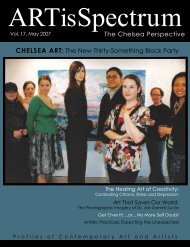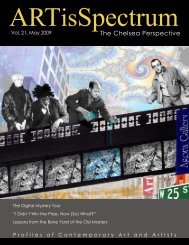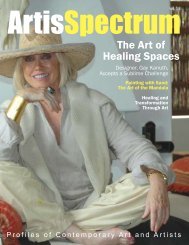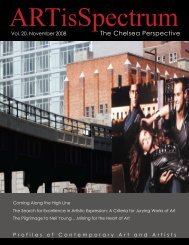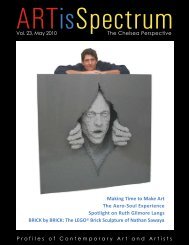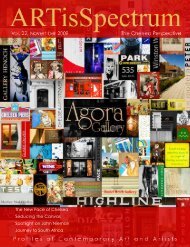Profiles of Contemporary Art and - ARTisSpectrum
Profiles of Contemporary Art and - ARTisSpectrum
Profiles of Contemporary Art and - ARTisSpectrum
Create successful ePaper yourself
Turn your PDF publications into a flip-book with our unique Google optimized e-Paper software.
The Wild Child <strong>of</strong> Impressionism at 100<br />
Revisiting Cubism<br />
by David J. LaBella<br />
Having lived through the turmoil <strong>and</strong> ferment<br />
<strong>of</strong> the twentieth century, it is not<br />
surprising that, in our hubris <strong>and</strong> shortsightedness,<br />
we largely dismiss the similar<br />
character <strong>of</strong> the century that had come<br />
before, the 1800’s. Marked by nearly as<br />
is, perhaps, even more true in art than in<br />
many other <strong>of</strong> the attributes <strong>and</strong> forces that<br />
color <strong>and</strong> shape our history; for it is in the<br />
latter half <strong>of</strong> the nineteenth century that<br />
the accelerating evolution from traditional<br />
painting into Romantic painting bore the<br />
“No high-minded painter <strong>of</strong> the last fifty<br />
years has been able to come to terms<br />
with his art without coming to terms with<br />
the problem <strong>of</strong> Cubism.” ~Josef Albers,<br />
German-born American painter <strong>and</strong> art<br />
pr<strong>of</strong>essor.<br />
Ping He - HP025 Acrylic on Canvas 29” x 20”<br />
full <strong>of</strong> a measure <strong>of</strong> war, human suffering,<br />
<strong>and</strong> socio-political heartache as the century<br />
just passed, the events <strong>of</strong> the nineteenth<br />
century easily rival any other such period<br />
in western history for drama <strong>and</strong> seminal,<br />
gatepost moments that have left their mark<br />
on the collective human experience. This<br />
revolutionary <strong>and</strong> liberating fruit that came<br />
to be known as Impressionism – a method<br />
<strong>and</strong> style <strong>of</strong> depicting the world that violated<br />
the accepted rules <strong>of</strong> convention <strong>and</strong><br />
schooling in art <strong>and</strong> created a new method<br />
<strong>and</strong> vocabulary that set loose forces in the<br />
art word that reverberate to this day.<br />
The maturation <strong>and</strong> diversification <strong>of</strong> the<br />
Impressionist period’s transformation <strong>of</strong><br />
illustrative art was rapid <strong>and</strong> radical. It<br />
moved from having been chained firmly to<br />
the allegorical realism <strong>of</strong> European painting<br />
<strong>and</strong> early American painting to a more<br />
free-form expression <strong>of</strong> light, form, <strong>and</strong> subject.<br />
Suddenly, the intent <strong>of</strong> the artist owed<br />
little or nothing to historical context or the<br />
dictations <strong>of</strong> traditionalism set forth (as if in<br />
stone) by Ruskin. This process was viewed<br />
with disdain by the critics <strong>of</strong> the day, who<br />
would have preferred that painting remain<br />
unchanged indefinitely – held captive to a<br />
methodology <strong>and</strong> ideology <strong>and</strong> preserved,<br />
in a sense, forever in amber – cold, immutable,<br />
<strong>and</strong> permanent. It was not to be<br />
– Europe <strong>and</strong> America were being swept by<br />
social, economic, <strong>and</strong> political forces that<br />
were rapidly transforming western culture<br />
with industrialization <strong>and</strong> a dizzying array<br />
<strong>of</strong> philosophical ideas that would ultimately,<br />
<strong>and</strong> with increasing intensity, alter life in<br />
the Western world forever <strong>and</strong> set in motion<br />
conflicts <strong>and</strong> crises beyond the darkest<br />
dreams <strong>of</strong> anyone living in the nineteenth<br />
century. So, too, with Impressionism, which<br />
quickly distilled itself into Post-Impressionism,<br />
Neo-Impressionism, Fauvism, <strong>and</strong> Expressionism<br />
– all artistic representations <strong>of</strong><br />
the diversity <strong>and</strong> blooming self-awareness<br />
<strong>and</strong> individuality <strong>of</strong> the artists involved in<br />
the process; each creating <strong>and</strong> defining a<br />
new, unique artistic vocabulary <strong>and</strong> owing<br />
less <strong>and</strong> less to the traditional forms they so<br />
eagerly sought to ab<strong>and</strong>on.<br />
“Cubism is like st<strong>and</strong>ing at a certain point<br />
on a mountain <strong>and</strong> looking around. If you<br />
go higher, things will look different; if you go<br />
lower, again they will look different. It is a<br />
point <strong>of</strong> view.”<br />
~Jacques Lipchitz, Cubist sculptor.<br />
<strong>Art</strong> is no different from other aspects <strong>of</strong> human<br />
evolution. It moves at a pace that is<br />
50 <strong>ARTisSpectrum</strong>





